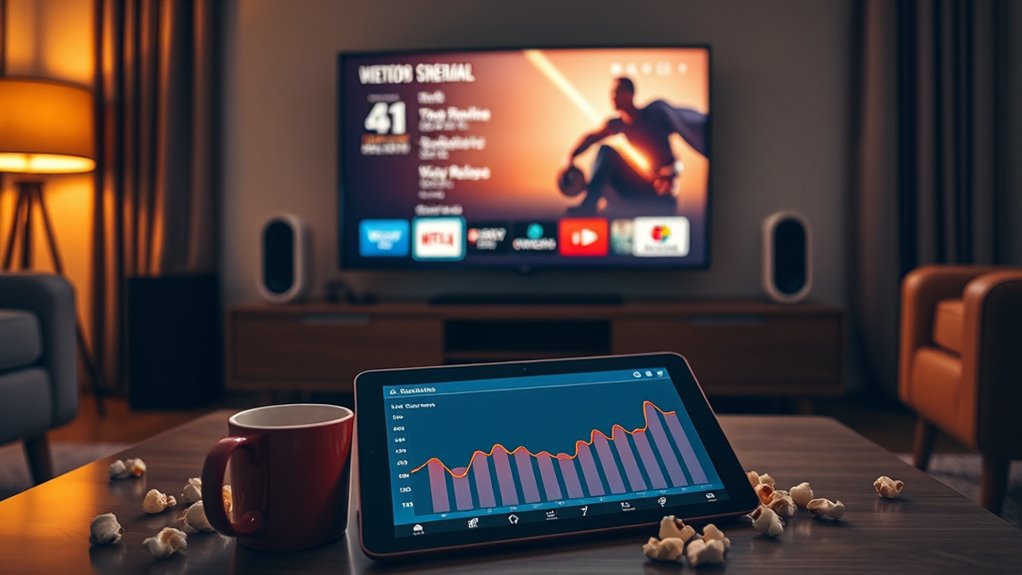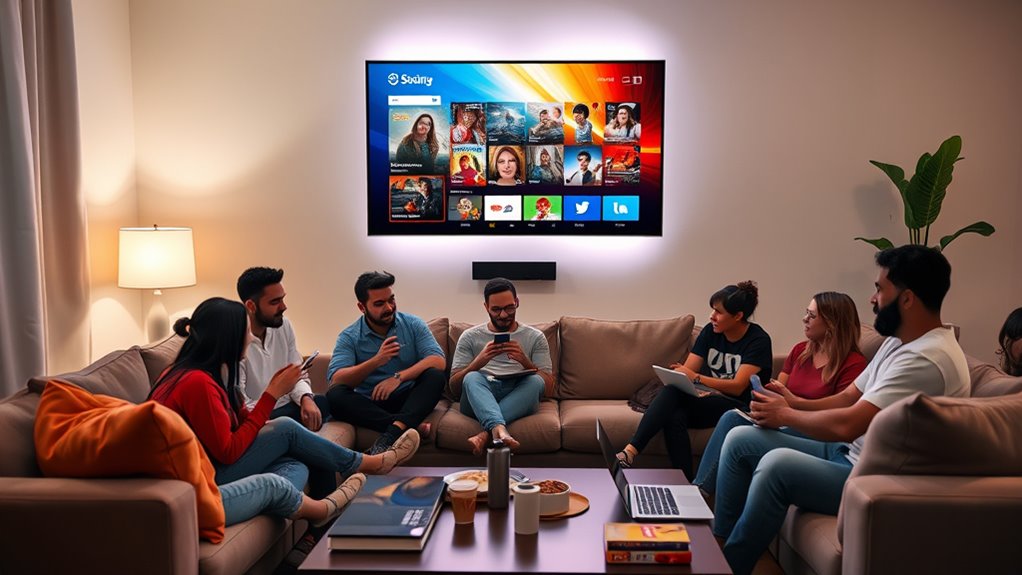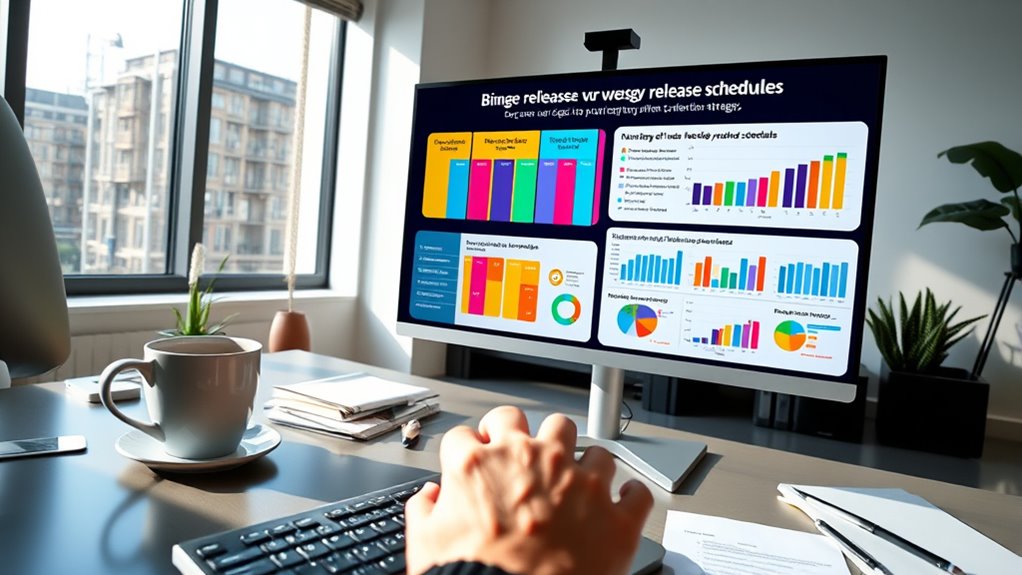Binge releases are giving way to more traditional, weekly release strategies as streaming platforms aim to boost long-term engagement and reduce subscriber churn. This shift caters to different viewer habits, with audiences now enjoying a hybrid approach that combines initial drops with ongoing weekly episodes. Major platforms are experimenting with these methods to personalize content delivery and maximize revenue. If you keep exploring, you’ll uncover how these trends could shape the future of streaming.
Key Takeaways
- Streaming platforms are shifting from exclusive binge drops to hybrid release models to boost engagement and reduce subscriber churn.
- Weekly releases foster ongoing viewer anticipation and align with traditional TV viewing habits.
- Data analytics and audience preferences are driving personalized scheduling, favoring varied release strategies over binge-only drops.
- Gradual releases extend viewer engagement, providing more promotional opportunities and increasing long-term platform activity.
- Industry trends indicate a move away from full binge releases toward flexible, hybrid approaches to remain competitive.
The Rise of Hybrid Release Models

The rise of hybrid release models marks a significant shift in how streaming platforms deliver their content. Instead of releasing entire seasons at once, platforms now combine initial batches with weekly drops to keep viewers engaged longer. This approach balances the instant gratification of binge-watching with the anticipation of weekly releases, encouraging sustained interest. By adopting hybrid strategies, platforms can reduce subscriber churn and boost ongoing searches for new episodes. They also gain more control over marketing efforts, spreading out promotional activities. This model caters to diverse viewer preferences, offering both quick access and scheduled viewing. As a result, streaming services aim to maximize revenue while fostering deeper engagement, aligning with broader industry trends toward more strategic, audience-focused content delivery. Regular audits enhance compliance with industry standards, ensuring these strategies meet quality assurance benchmarks and deliver consistent viewer satisfaction.
Audience Engagement and Viewing Habits

You notice that as content releases change, your anticipation can grow over time, especially with weekly drops. Your genre preferences also influence how you engage, with action fans often binge and comedy lovers sometimes prefer waiting. These shifting viewing patterns shape how platforms craft their release strategies to keep you interested longer. Additionally, smart content delivery technologies are enabling personalized viewing schedules that adapt to individual habits, further affecting how audiences consume new releases.
Anticipation Builds Over Time
As streaming platforms adopt varied release strategies, anticipation naturally builds over time, shaping how you engage with content. Weekly releases create a sense of ongoing excitement, encouraging you to check back regularly. This sustained anticipation keeps you invested longer, increasing overall engagement. The table below shows how release methods influence your viewing habits:
| Release Strategy | Impact on Anticipation | Viewer Behavior |
|---|---|---|
| Binge Release | Instant gratification, quick binge | Finish quickly, less waiting |
| Weekly Release | Gradual buildup, sustained interest | Look forward to episodes, discuss online |
| Hybrid Approach | Balance of both, prolonged engagement | Mix of immediate and delayed gratification |
This approach fuels ongoing conversations and deepens your connection to the series. Additionally, understanding how content delivery influences viewer habits can help platforms tailor their release strategies to maximize engagement.
Genre Preferences Vary
Different genres and audience segments respond uniquely to various release strategies, shaping how you engage with content. Action and adventure fans often prefer binge releases, savoring fast-paced stories in one sitting. Meanwhile, viewers of dramas or complex mysteries tend to favor weekly drops, allowing time to digest each episode and build anticipation. Comedies, especially among older audiences, often see higher engagement with weekly releases, mimicking traditional TV habits. Younger viewers, used to instant gratification, might lean toward binge-watching everything immediately. Your viewing habits are influenced by genre preferences, which in turn guide platforms’ release strategies. Recognizing these differences helps content creators and streamers tailor their approaches, ensuring they meet the expectations of diverse audiences and maximize engagement. Understanding viewer preferences plays a crucial role in designing effective release schedules to cater to different audience behaviors.
Viewing Patterns Shift
Viewing patterns are evolving rapidly as audiences adapt to new release strategies and technological advances. You now find yourself balancing the desire for immediate gratification with sustained engagement. Weekly releases keep you excited and returning for more, mimicking traditional TV habits, while binge releases offer instant satisfaction. Different genres and demographic groups prefer different approaches; younger viewers often binge action series, while older audiences may favor weekly comedy drops. Platforms analyze your viewing habits and feedback to refine their release schedules, aiming to maximize your engagement. This shift toward mixed strategies encourages you to explore more content over time, shifting your behavior from quick binge sessions to sustained, anticipation-driven viewing. Additionally, the cost of content production influences how platforms choose their release strategies, balancing budget constraints with audience preferences. As a result, your overall interaction with streaming services becomes more dynamic and tailored.
Demographic Preferences in Streaming

Demographic preferences considerably influence how streaming platforms choose their release strategies. You might notice that younger viewers often prefer binge releases for high-adrenaline genres like action and adventure, while older audiences tend to favor weekly drops, especially for comedies and dramas. These preferences shape content scheduling decisions to maximize engagement. Additionally, understanding maximizing space and organization can help platforms optimize their content libraries and user interfaces to better cater to different viewer habits.
Industry Shifts Toward Strategic Content Delivery

As streaming platforms recognize the varying preferences across audiences, they are increasingly adopting strategic approaches to content delivery. They’re shifting from solely releasing entire seasons at once to hybrid models combining initial batches with weekly drops. This approach helps balance immediate viewer satisfaction with long-term engagement, reducing subscriber churn. Platforms like Prime Video and Netflix experiment with different strategies to cater to diverse tastes. Weekly releases foster ongoing anticipation, encouraging viewers to return regularly. They also mirror traditional TV schedules, promoting sustained habits. These shifts are driven by data analytics and audience feedback, allowing platforms to optimize release timing and content scheduling. Additionally, the use of expert voice actors in promotional materials can enhance viewer engagement and credibility. Ultimately, this strategic content delivery aims to enhance viewer retention, drive subscriptions, and stay competitive in a crowded streaming landscape.
Major Platforms Embracing New Strategies

Major streaming platforms are actively adopting and experimenting with new release strategies to stay competitive and better serve their audiences. They’re shifting away from pure binge drops and exploring hybrid models, combining weekly releases with all-at-once options. This approach aims to boost viewer engagement, reduce churn, and adapt to diverse preferences. You’ll see platforms like Netflix experimenting with split-season drops, while Disney+ leverages weekly releases for Marvel shows to maintain buzz. Prime Video balances both methods depending on the content, and HBO Max uses hybrid strategies for licensed titles. These shifts reflect a broader effort to innovate, retain subscribers, and maximize revenue, all driven by data insights and evolving viewer habits. Incorporating Kia Tuning techniques, some platforms are also tailoring release schedules based on audience preferences to optimize content performance.
Economic Benefits of Gradual Releases

Gradual release schedules offer significant economic advantages for streaming platforms by extending viewer engagement and maximizing revenue opportunities. When you release content over several weeks, you keep subscribers hooked longer, encouraging ongoing subscriptions and reducing churn. This approach allows more time for marketing efforts, boosting visibility and attracting new viewers. It also creates multiple touchpoints for promoting related content, increasing overall platform activity. Additionally, steady releases can generate sustained buzz, which can translate into higher ad revenue and merchandise sales. By pacing content, platforms can better manage server loads and promotional budgets, making campaigns more cost-effective. Furthermore, implementing a well-planned release schedule can enhance content visibility and viewer anticipation, leading to increased subscriptions. Ultimately, these strategies help maintain a steady cash flow and increase the lifetime value of each subscriber, strengthening the platform’s financial health in a competitive market.
Technological Tools Shaping Release Decisions

You can leverage data analytics to analyze viewer behavior and optimize release schedules for maximum engagement. Real-time audience monitoring lets you adjust strategies quickly based on how viewers respond. Personalization algorithms help tailor release approaches to individual preferences, enhancing overall satisfaction and retention. Additionally, understanding Beginners Guides can provide insights into effective content presentation and audience education techniques.
Data Analytics Optimization
Data analytics has become a crucial tool for streaming platforms to optimize their release strategies, enabling them to make informed decisions based on real-time viewer behavior. By analyzing data, you can identify peak engagement times, preferred genres, and audience drop-off points. This insight allows you to tailor release schedules that maximize viewer retention and satisfaction.
- Track viewing patterns across different demographics
- Measure engagement spikes following specific release strategies
- Use predictive analytics to forecast content popularity
- Adjust release timing based on viewer activity data
- Personalize recommendations to boost ongoing engagement
Leveraging these tools helps you refine your approach, balancing binge and weekly releases to boost subscriber loyalty and stay competitive in a rapidly evolving market. Data-driven decisions ensure your content strategy aligns perfectly with audience preferences.
Real-Time Audience Monitoring
Real-time audience monitoring tools are transforming how streaming platforms decide when and how to release content. By analyzing live viewing data, these tools give you immediate insights into viewer engagement, preferences, and behavior patterns. Platforms can track which episodes or scenes generate the most attention and identify drop-off points, helping you optimize release timing and marketing strategies. This instant feedback allows for quick adjustments, such as releasing new episodes at peak engagement times or promoting specific content to boost viewership. You’re empowered to make data-driven decisions that maximize subscriber retention and satisfaction. With advanced analytics, streaming services can also predict future viewer trends, enabling proactive scheduling that aligns with audience habits—ultimately shaping more strategic, responsive release strategies.
Personalization Algorithms
Personalization algorithms have become essential tools for streaming platforms to tailor content release strategies to individual viewers. These algorithms analyze your viewing habits, preferences, and engagement patterns to optimize when and what content gets released. They help platforms decide whether to drop an entire season at once or release episodes weekly.
- Predict your favorite genres and tailor release schedules accordingly
- Adjust content suggestions based on your viewing time and habits
- Identify trends to optimize release timing for maximum engagement
- Personalize notifications to build anticipation for upcoming drops
- Use real-time data to experiment with hybrid release models
Future Trends in Streaming Content Releases

As streaming platforms continue to evolve, flexible and hybrid release models are expected to dominate the future landscape. You’ll see a shift toward combining binge releases with weekly drops, creating a more engaging and sustainable viewing experience. This approach caters to diverse audience preferences and helps platforms maintain long-term subscriber interest. Innovation will focus on personalization, allowing viewers to choose how they access content. Data analytics will guide these decisions, optimizing release timing for maximum engagement. The table below captures the emotional impact of these trends:
| Anticipation | Satisfaction | Loyalty |
|---|---|---|
| Builds excitement over time | Delivers immediate gratification | Keeps viewers coming back |
| Creates ongoing buzz | Encourages binge-watching | Fosters brand attachment |
| Drives social conversations | Sustains interest | Cultivates community |
| Inspires curiosity | Rewards patience | Develops trust |
| Adds unpredictability | Enhances enjoyment | Strengthens loyalty |
Impact of Release Strategies on Market Competition

The way streaming platforms release their content directly influences market competition by shaping viewer preferences and retention strategies. You’ll notice platforms adopt different methods to stand out, such as hybrid models or weekly drops, to keep subscribers engaged longer. This pushes competitors to innovate continuously, aiming to attract and retain audiences. Consider these key impacts:
- Encourages innovation in release scheduling to differentiate content.
- Influences subscriber loyalty through strategic release timing.
- Creates market fragmentation by catering to diverse viewer habits.
- Drives competition in content quality and release methods.
- Impacts pricing and subscription models based on viewer engagement patterns.
Frequently Asked Questions
How Do Personalized Viewer Data Influence Specific Release Schedule Choices?
You see personalized viewer data influencing release schedules by helping platforms tailor content delivery to individual preferences. When data shows you prefer weekly drops or specific genres, they adjust release strategies to keep you engaged longer. This active use of analytics allows streaming services to optimize viewer retention, reduce churn, and boost satisfaction, ensuring you get content in formats and timings that suit your habits and maximize your overall experience.
What Role Does Viewer Feedback Play in Adjusting Streaming Release Strategies?
Viewer feedback plays a vital role in shaping streaming release strategies. You might think platforms ignore audience opinions, but they actively analyze comments and engagement data to fine-tune scheduling. If viewers express frustration with long waits, platforms may introduce more weekly releases. Conversely, high satisfaction with binge releases prompts some to stick with all-at-once drops. Ultimately, platforms adapt to your preferences to boost engagement, retention, and satisfaction.
Are There Differences in Release Preferences Across Global Markets or Regions?
You’ll notice that release preferences vary across regions. In North America and Europe, audiences often prefer weekly releases, aligning with traditional TV habits and building anticipation. Meanwhile, younger viewers in Asia and Latin America might favor binge releases for quick consumption. Streaming platforms adapt their strategies accordingly, using data to cater to local tastes, ensuring they maximize engagement and retention across diverse markets.
How Do Licensing Agreements Impact the Adoption of Weekly Versus Binge Releases?
Like a chess game, licensing agreements shape your streaming options. They often determine whether you get a full season at once or a staggered weekly release. If licenses are tight or expire quickly, platforms prefer binge releases for instant impact. Conversely, flexible agreements allow for weekly drops, keeping viewers engaged longer. So, licensing agreements serve as the hidden pawns influencing your viewing experience, balancing content rights and audience retention.
What Technological Innovations Are Expected to Further Transform Release Planning?
You can expect data analytics and AI to revolutionize release planning further. These innovations will help platforms analyze viewer behavior in real-time, allowing you to tailor release schedules that maximize engagement and retention. Personalized recommendations and adaptive algorithms will enable you to predict ideal release times for different genres and demographics, making content delivery more strategic and flexible. As technology advances, your streaming experience will become more customized and responsive to your viewing habits.
Conclusion
As streaming platforms experiment with release strategies, you should know that 70% of viewers prefer weekly releases over binge drops, highlighting a shift towards sustained engagement. This approach keeps audiences anticipating content and fosters ongoing conversation. If you’re a creator or platform, embracing strategic, gradual releases could boost viewer loyalty and competitive edge. As industry trends evolve, staying adaptable and understanding audience preferences will be your key to thriving in this changing landscape.










